Processing of Al2O3-AlN Ceramics and Their Structural, Mechanical, and Tribological Characterization
Abstract
1. Introduction
2. Materials and Experimental Methods
2.1. Materials
2.2. Experimental Methods
2.2.1. Oxidation and Sintering of Powders
2.2.2. Density Measurements
2.2.3. Mechanical Tests
2.2.4. Tribological Characterization
2.2.5. Microstructure and Morphological Characterization
3. Results and Discussion
3.1. Oxidation of AlN Powders and Subsequent HIP Sintering
3.2. Morphological Investigation of the Oxidized Powders and Sintered Samples
3.3. Structural Investigation of the Oxidized Powders and Sintered Samples by XRD
3.4. Mechanical Testing of the HIP Sintered Composites
3.5. Tribological Investigations on AlN-Al2O3 Samples
3.5.1. Experimental Investigations
3.5.2. Morphological Study on Samples Subjected to Tribology Measurements
4. Conclusions
- The preparation of composite AlN-Al2O3 ceramics was carried out by oxidation of pure AlN powders and subsequent hot isostatic pressing.
- The oxidized AlN powders have developed two distinct phases of aluminum oxide (α-Al2O3 and θ-Al2O3). The transformation depended on the time of oxidation with lower percentage of conversion obtained after 3 h and near complete transformation of AlN to Al2O3 at 20-h oxidation.
- The sintered samples showed the presence of only α-Al2O3 besides AlN proving that the sintering results in disintegration of θ-Al2O3 phase.
- Upon sintering, the substrates showed marked improvement in the density with a reduction in the porosity. The experiments also proved that densification in sintered samples can be achieved by HIP sintering particularly at lower temperatures (<1800 °C). The measured density values were in agreement with values reported in literature.
- Mechanical tests showed considerable improvement in the bending strength and microhardness of the sintered substrates. However, superior properties in both the cases were observed in samples S10 followed by S20.
- According to the tribology tests, the samples showed considerably good wear property. Furthermore, the extensive tribofilm formation, brittleness, and surface cracks observed during the experimentation are due to the presence of clusters of Al2O3 at the AlN surface. The extensive tribofilm formation provided a stable friction behavior (S3), whereas the lower amount of tribofilm (S10) or no tribofilm formation on smooth surface (S20) resulted in unstable frictional behavior.
Author Contributions
Funding
Institutional Review Board Statement
Informed Consent Statement
Acknowledgments
Conflicts of Interest
References
- Yamaguchi, G.; Yanagida, H. Study on the reductive spinel—A new spinel formula AlN–Al2O3 instead of the previous one Al3O4. Bull. Chem. Soc. Jpn. 1959, 32, 1264–1265. [Google Scholar] [CrossRef]
- Long, G.; Foster, L.M. Crystal phases in the system Al2O3–AlN. J. Am. Ceram. Soc. 1961, 44, 255–258. [Google Scholar] [CrossRef]
- Adams, I.; Au Coin, T.R.; Wolff, G.A. Luminescence in the system Al2O3–AlN. J. Electrochem. Soc. 1962, 109, 1050–1054. [Google Scholar] [CrossRef]
- Irene, E.A.; Silvestri, V.J.; Woolhouse, G.R. Some properties of chemically vapor deposited films of AlxOyNz on silicon. J. Electron. Mater. 1975, 4, 409–427. [Google Scholar] [CrossRef]
- McCauley, J.W.; Patel, P.; Chen, M.; Gilde, G.; Strassburger, E.; Paliwal, B.; Dandekar, D.P. AlON: A brief history of its emergence and evolution. J. Eur. Ceram. Soc. 2009, 29, 223–236. [Google Scholar] [CrossRef]
- McCauley, J.W. Reaction studies in Si3N4-Al2O3 system Amer. Cer. Soc. Bull. 1974, 53, 620. [Google Scholar]
- McCauley, J.W. A simple model for aluminum oxynitride spinels. J. Am. Ceram. Soc. 1978, 61, 372–373. [Google Scholar] [CrossRef]
- McCauley, J.W.; Viechnicki, D.J.; Corbin, N.D.; Corkum, D.H. Stability of a spinel phase in the Al2O3–AlN system. Ceram. Soc. Bull. 1977, 56, 301. [Google Scholar]
- McCauley, J.W. Sintered Polycrystalline Nitrogen Stabilized Cubic Aluminum Oxide Material; Department of the Army Washington D.C.: Washington, DC, USA, 1978.
- McCauley, J.W.; Corbin, N.D. Phase relations and reaction sintering of transparent cubic aluminum oxynitride spinel (ALON). J. Am. Ceram. Soc. 1979, 62, 476–479. [Google Scholar] [CrossRef]
- Gentilman, R.L.; Maguire, E.A.; Dolhert, L.E. Transparent Aluminum Oxynitride and Method of Manufacture. U.S. Patent No. 4,520,116, 28 May 1985. [Google Scholar]
- McCauley, J.W. Structure and Properties of Aluminum Nitride and AlON Ceramics; Army Research Lab, Weapons and Materials Research Dirrectorat: Aberdeen, MD, USA, 2002. [Google Scholar]
- Corbin, N.D. Aluminum oxynitride spinel: A review. J. Eur. Ceram. Soc. 1989, 5, 143–154. [Google Scholar] [CrossRef]
- Prosvirnin, D.V.; Kolmakov, A.G.; Larionov, M.D.; Prutskov, M.E.; Levina, A.V. Methods and techniques for producing ceramics from aluminum oxynitride. In IOP Conference Series: Materials Science and Engineering; IOP Publishing: Bristol, UK, 2019; Volume 525, p. 012067. [Google Scholar]
- Balázsi, C.; Furkó, M.; Szira, F.; Balázsi, K. Research on Technical Ceramics and their Industrial Application: Preparation Techniques and Properties of Transparent AlON Ceramics. Acta Mater. Transylvanica 2019, 2, 7–12. [Google Scholar] [CrossRef]
- Kim, Y.W.; Park, B.H.; Park, H.C.; Lee, Y.B.; Oh, K.D.; Riley, F. Sintering, microstructure and mechanical properties of AlON–AlN particulate composites. Br. Ceram. Trans. 1998, 97, 97–104. [Google Scholar]
- Kim, Y.W.; Park, H.C.; Lee, Y.B.; Oh, K.D.; Stevens, R. Reaction sintering and microstructural development in the system Al2O3–AlN. J. Eur. Ceram. Soc. 2001, 21, 2383–2391. [Google Scholar] [CrossRef]
- Maghsoudipour, A.; Bahrevar, M.A.; Heinrich, J.G.; Moztarzadeh, F. Reaction sintering of AlN–AlON composites. J. Eur. Ceram. Soc. 2005, 25, 1067–1072. [Google Scholar] [CrossRef]
- Merzhanov, A.G. Self-propagating high-temperature synthesis: About the past, nowadays, and future. Izv. Vysh. Ucheb. Zav. Tsvet. Met. 2006, 5, 5–8. [Google Scholar]
- Borovinskaya, I.P.; Akopdzhanyan, T.G.; Ignatieva, T.I.; Chemagina, E.A. Structure and Phase Formation of Combustion Products during Γ-Alon Synthesis in Shs Gas-Statting Mode. Izv. Vysh. Zav. Por. Met. I Funct. Pokr. 2016, 3, 23–30. (In Russian) [Google Scholar] [CrossRef][Green Version]
- Zheng, J.; Forslund, B. Carbothermal synthesis of aluminium oxynitride (ALON) powder: Influence of starting materials and synthesis parameters. J. Eur. Ceram. Soc. 1995, 15, 1087–1100. [Google Scholar] [CrossRef]
- Yuan, X.; Liu, X.; Zhang, F.; Wang, S. Synthesis of γ-AlON powders by a combinational method of carbothermal reduction and solid-state reaction. J. Am. Ceram. Soc. 2010, 93, 22–24. [Google Scholar] [CrossRef]
- Jin, X.; Gao, L.; Sun, J.; Liu, Y.; Gui, L. Highly transparent AlON pressurelessly sintered from powder synthesized by a novel carbothermal nitridation method. J. Am. Ceram. Soc. 2012, 95, 2801–2807. [Google Scholar] [CrossRef]
- Liu, Q.; Jiang, N.; Li, J.; Sun, K.; Pan, Y.; Guo, J. Highly transparent AlON ceramics sintered from powder synthesized by carbothermal reduction nitridation. Ceram. Int. 2016, 42, 8290–8295. [Google Scholar] [CrossRef]
- Chen, Q.; Wang, Y.; Qi, J.; Wang, H. A contrast of carbothermal reduction synthesis of MgAlON and AlON powders for transparent ceramics. J. Alloys Compd. 2019, 791, 856–863. [Google Scholar] [CrossRef]
- Bandyopadhyay, S.; Rixecker, G.; Aldinger, F.; Pal, S.; Mukherjee, K.; Maiti, H.S. Effect of reaction parameters on γ-AlON formation from Al2O3 and AlN. J. Am. Ceram. Soc. 2002, 85, 1010–1012. [Google Scholar] [CrossRef]
- Zhang, N.; Liang, B.; Wang, X.Y.; Kan, H.M.; Zhu, K.W.; Zhao, X.J. The pressureless sintering and mechanical properties of AlON ceramic. Mater. Sci. Eng. A 2011, 528, 6259–6262. [Google Scholar] [CrossRef]
- Shan, Y.; Xu, J.; Wang, G.; Sun, X.; Liu, G.; Xu, J.; Li, J. A fast pressureless sintering method for transparent AlON ceramics by using a bimodal particle size distribution powder. Ceram. Int. 2015, 41, 3992–3998. [Google Scholar] [CrossRef]
- Shan, Y.; Zhang, Z.; Sun, X.; Xu, J.; Qin, Q.; Li, J. Fast densification mechanism of bimodal powder during pressureless sintering of transparent AlON ceramics. J. Eur. Ceram. Soc. 2016, 36, 671–678. [Google Scholar] [CrossRef]
- Min, J.H.; Lee, J.; Yoon, D.H. Fabrication of transparent γ-AlON by direct 2-step pressureless sintering of Al2O3 and AlN using an AlN-deficient composition. J. Eur. Ceram. Soc. 2019, 39, 4673–4679. [Google Scholar] [CrossRef]
- Shan, Y.; Wei, X.; Sun, X.; Xu, J.; Qin, Q.; Olevsky, E.A. Highly infrared transparent spark plasma sintered AlON ceramics. J. Mater. Res. 2017, 32, 3279–3285. [Google Scholar] [CrossRef]
- Li, X.; Luo, J.; Zhou, Y. Spark plasma sintering behavior of AlON ceramics doped with different concentrations of Y2O3. J. Eur. Ceram. Soc. 2015, 35, 2027–2032. [Google Scholar] [CrossRef]
- Sahin, F.C.; Kanbur, H.E.; Apak, B. Preparation of AlON ceramics via reactive spark plasma sintering. J. Eur. Ceram. Soc. 2012, 32, 925–929. [Google Scholar] [CrossRef]
- Li, X.; Huang, J.; Luo, J. Progress and challenges in the synthesis of AlON ceramics by spark plasma sintering. Trans. Indian Ceram. Soc. 2017, 76, 14–20. [Google Scholar] [CrossRef]
- Jiang, N.; Liu, Q.; Xie, T.; Ma, P.; Kou, H.; Pan, Y.; Li, J. Fabrication of highly transparent AlON ceramics by hot isostatic pressing post-treatment. J. Eur. Ceram. Soc. 2017, 37, 4213–4216. [Google Scholar] [CrossRef]
- Chen, F.; Zhang, F.; Wang, J.; Zhang, H.; Tian, R.; Zhang, Z.; Wang, S. Hot isostatic pressing of transparent AlON ceramics with Y2O3/La2O3 additives. J. Alloys Compd. 2015, 650, 753–757. [Google Scholar] [CrossRef]
- Chen, F.; Zhang, F.; Wang, J.; Zhang, H.; Tian, R.; Zhang, J.; Zhang, Z.; Sun, F.; Wang, S. Microstructure and optical properties of transparent aluminum oxynitride ceramics by hot isostatic pressing. Scr. Mater. 2014, 81, 20–23. [Google Scholar] [CrossRef]
- Feng, Z.; Qi, J.; Guo, X.; Wang, Y.; Cao, X.; Yu, Y.; Meng, C.; Lu, T. A new and highly active sintering additive: SiO2 for highly-transparent AlON ceramic. J. Alloys Compd. 2019, 787, 254–259. [Google Scholar] [CrossRef]
- Atkinson, H.V.; Davies, S. Fundamental aspects of hot isostatic pressing: An overview. Metall. Mater. Trans. A 2000, 31, 2981–3000. [Google Scholar] [CrossRef]
- Xue, J.M.; Liu, Q.; Xiu, T.P.; Ma, L.L.; Fang, M.; Gui, L.H. Hot-pressed translucent aluminum oxynitride (AlON) ceramics. In Key Engineering Materials; Trans Tech Publications Ltd.: Freienbach, Switzerland, 2008; Volume 368, pp. 450–452. [Google Scholar]
- Suryanarayana, D. Oxidation kinetics of aluminum nitride. J. Am. Ceram. Soc. 1990, 73, 1108–1110. [Google Scholar] [CrossRef]
- Bellosi, A.; Landi, E.; Tampieri, A. Oxidation behavior of aluminum nitride. J. Mater. Res. 1993, 8, 565–572. [Google Scholar] [CrossRef]
- Brown, A.L.; Norton, M.G. Oxidation kinetics of AlN powder. J. Mater. Sci. Lett. 1998, 17, 1519–1522. [Google Scholar] [CrossRef]
- Lin, C.Y.; Lu, F.H. Oxidation behavior of AlN films at high temperature under controlled atmosphere. J. Eur. Ceram. Soc. 2008, 28, 691–698. [Google Scholar] [CrossRef]
- Duchesne, D.J.; Hipps, K.W.; Grasher, B.A.; Norton, M.G. The formation of transition aluminas during oxidation of AlN. J. Mater. Sci. Lett. 1999, 18, 877–879. [Google Scholar] [CrossRef]
- Gu, Z.; Edgar, J.H.; Wang, C.; Coffey, D.W. Thermal oxidation of aluminum nitride powder. J. Am. Ceram. Soc. 2006, 89, 2167–2171. [Google Scholar] [CrossRef]
- Spivak, I.I.; Rystsov, V.N.; Lazarenko, V.D. Creep of Al2O3-AlN and Y2O3-AlN ceramics. Sov. Powder Metall. Met. Ceram. 1976, 15, 143–148. [Google Scholar] [CrossRef]
- Abyzov, A.M. Aluminum oxide and alumina ceramics (review). Part 1. Properties of Al2O3 and commercial production of dispersed Al2O3. Refract. Ind. Ceram. 2019, 60, 24–32. [Google Scholar] [CrossRef]
- Swab, J.J.; Pavlacka, R.; Gilde, G.; Kilczewski, S.; Wright, J.; Harris, D. Determining the strength of coarse-grained AlON and spinel. J. Am. Ceram. Soc. 2014, 97, 592–600. [Google Scholar] [CrossRef]
- Quinn, G.D.; Corbin, N.D.; McCauley, J.W. Thermomechanical properties of aluminum oxynitride spinel. Am. Ceram. Soc. Bull. 1984, 63, 723–730. [Google Scholar]
- Willems, H.X.; Van Hal, P.F.; Metselaar, R. Mechanical properties of γ-aluminium oxynitride. J. Mater. Sci. 1993, 28, 6185–6189. [Google Scholar] [CrossRef]
- Scherbakov, S.P. Influence of a discrete additive of aluminum oxide on structure and properties of aluminum alloy. J. Min. Inst. 2017, 228, 717–721. [Google Scholar]
- Ceniga, L. Analytical Models of Thermal and Phase-Transformation-Induced Stresses in Materials with Void Defects II; Nova Science Publishers: New York, NY, USA, 2019; p. 262. ISBN 978-1-53614-982-1. [Google Scholar]
- Zhao, X.J.; Guo, L.; Cai, Z.Y.; Xiao, L.R.; Zhao, Z.W.; Li, G.; Han, J.; Ru, H.Q.; Zhang, N.; Chen, D.L. SiC and ZrN nano-particulate reinforced AlON composites: Preparation, mechanical properties and toughening mechanisms. Ceram. Int. 2016, 42, 6072–6079. [Google Scholar] [CrossRef]
- Panasyuk, A.D.; Struk, L.I.; Yuga, A.I.; Kolesnichenko, L.F.; Neshpor, I.P.; Fushchich, O.I. Tribological properties of nonmetallic nitride-base ceramic materials. I. Frictional characteristics of aluminum nitride-base composite materials. Sov. Powder Metall. Met. Ceram. 1990, 29, 655–659. [Google Scholar] [CrossRef]
- Keshri, A.K.; Huang, J.; Singh, V.; Choi, W.; Seal, S.; Agarwal, A. Synthesis of aluminum oxide coating with carbon nanotube reinforcement produced by chemical vapor deposition for improved fracture and wear resistance. Carbon 2010, 48, 431–442. [Google Scholar] [CrossRef]
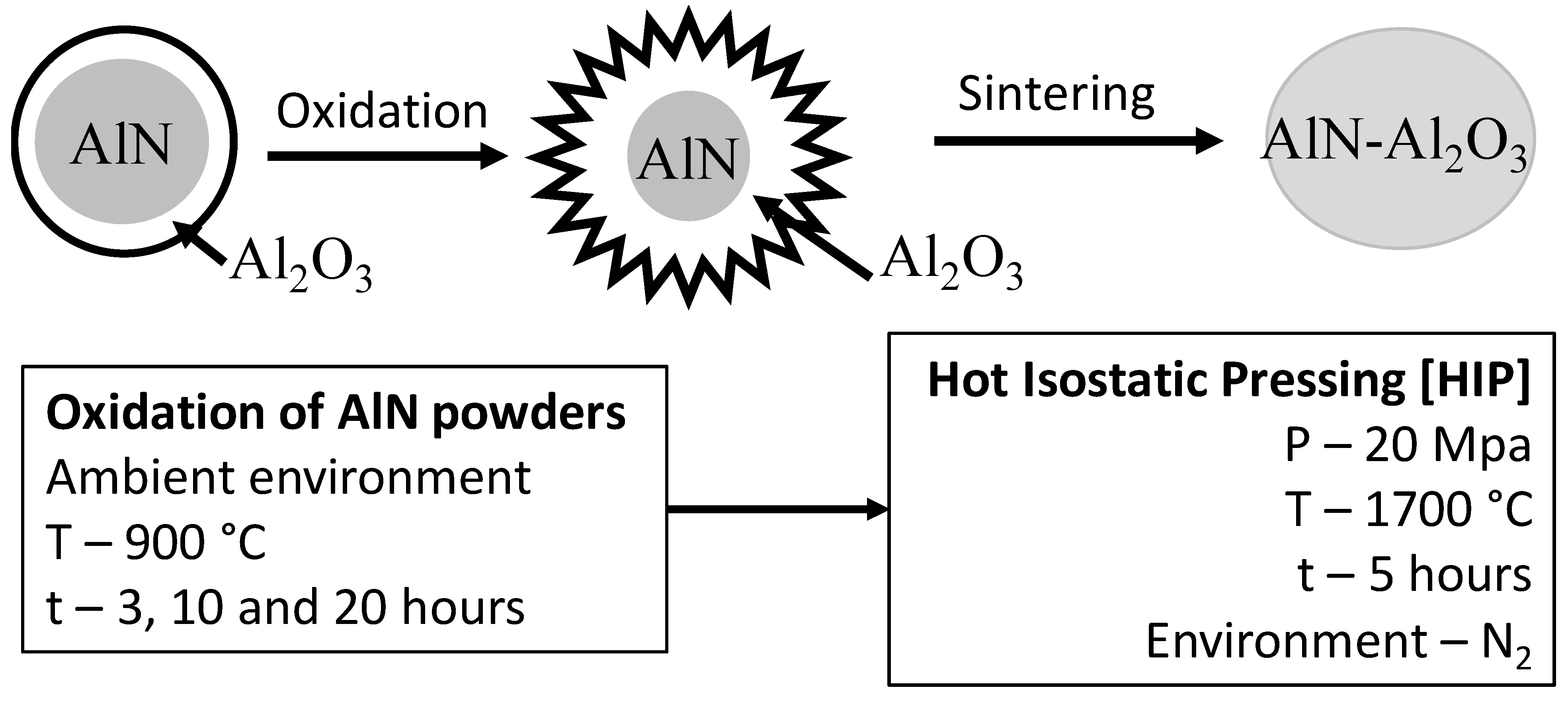
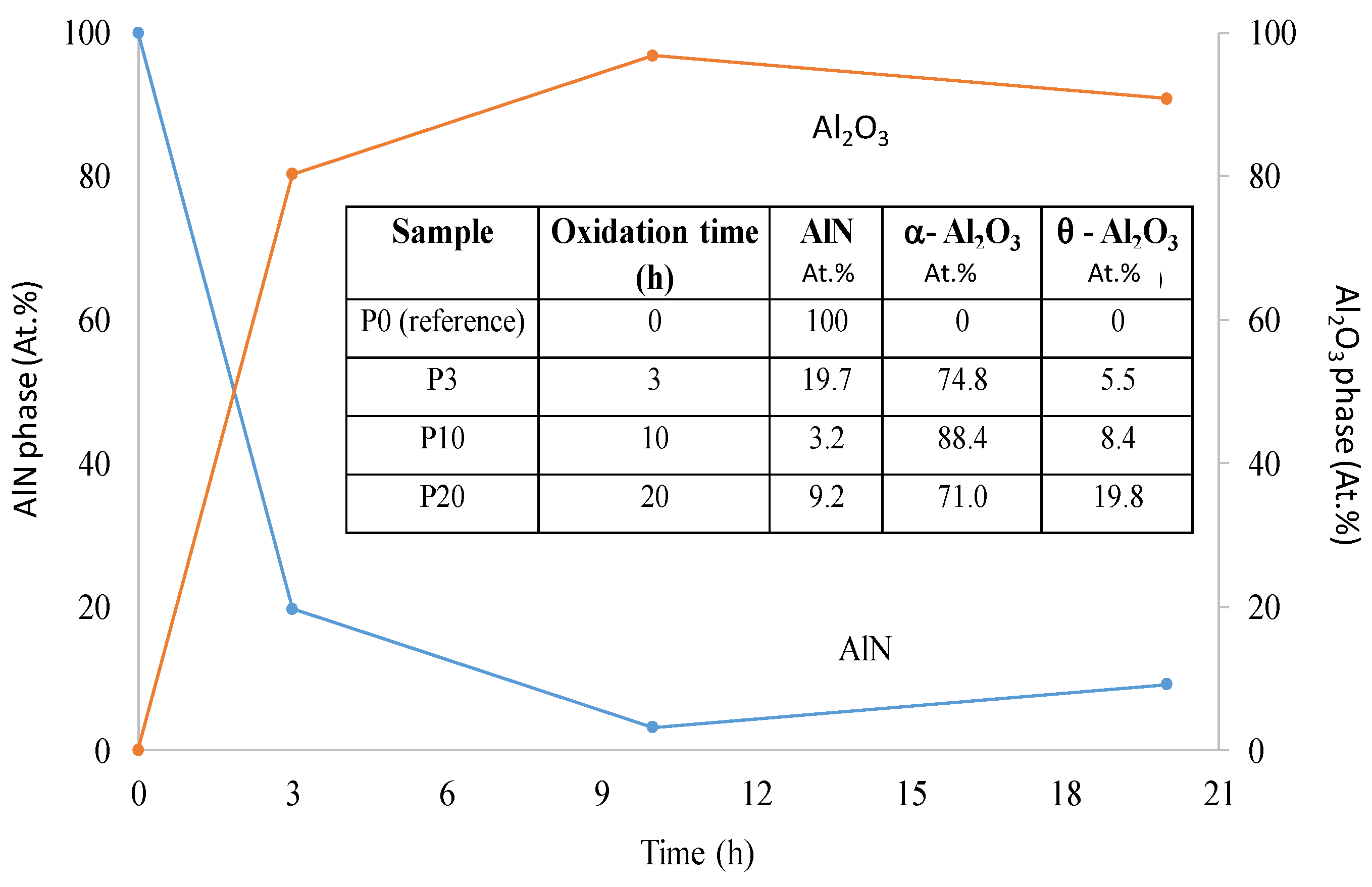
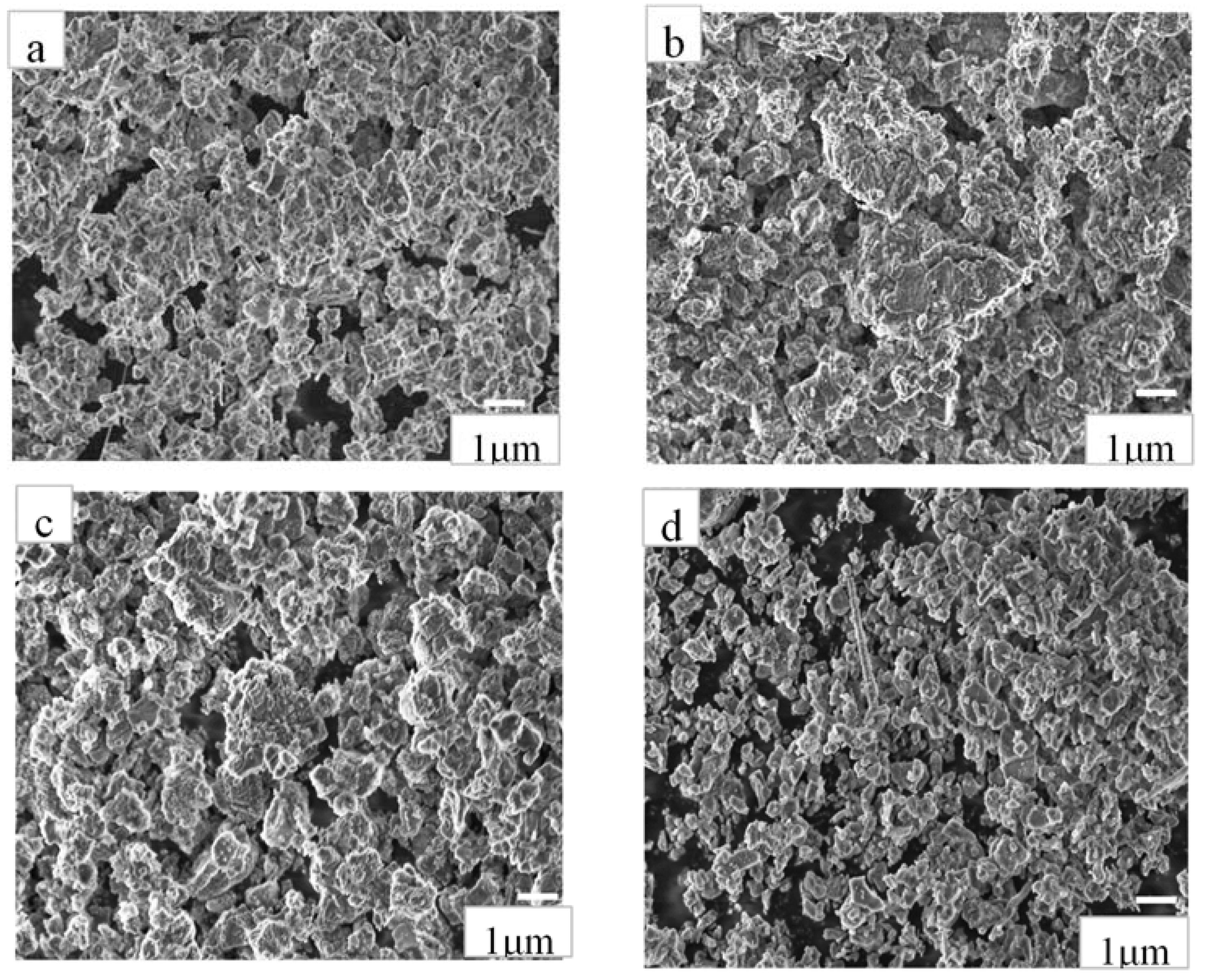
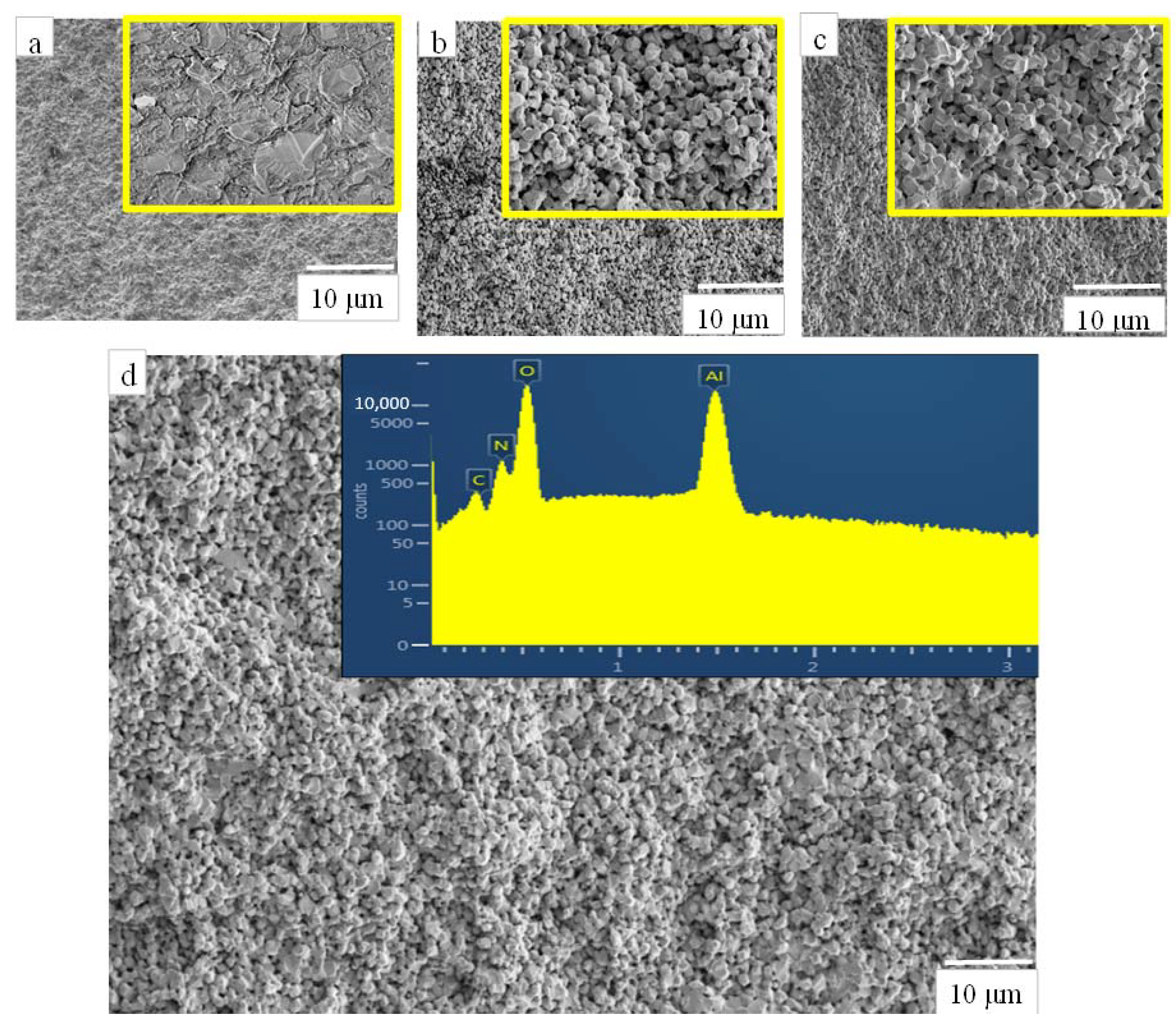

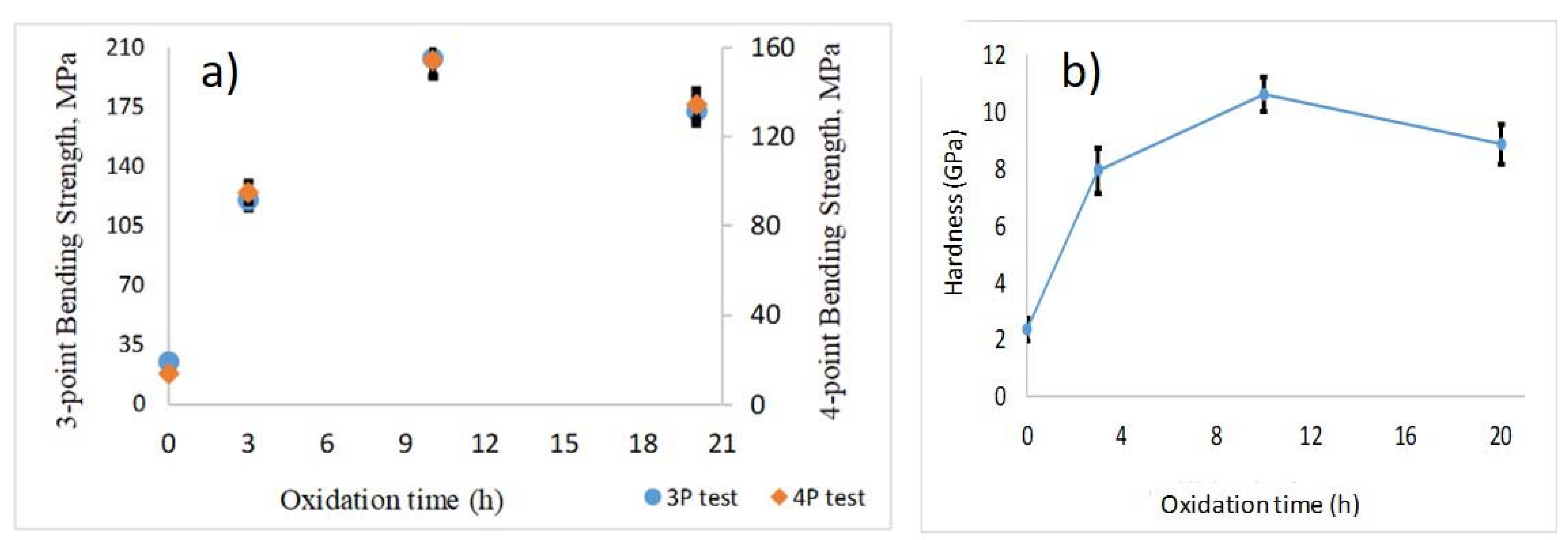
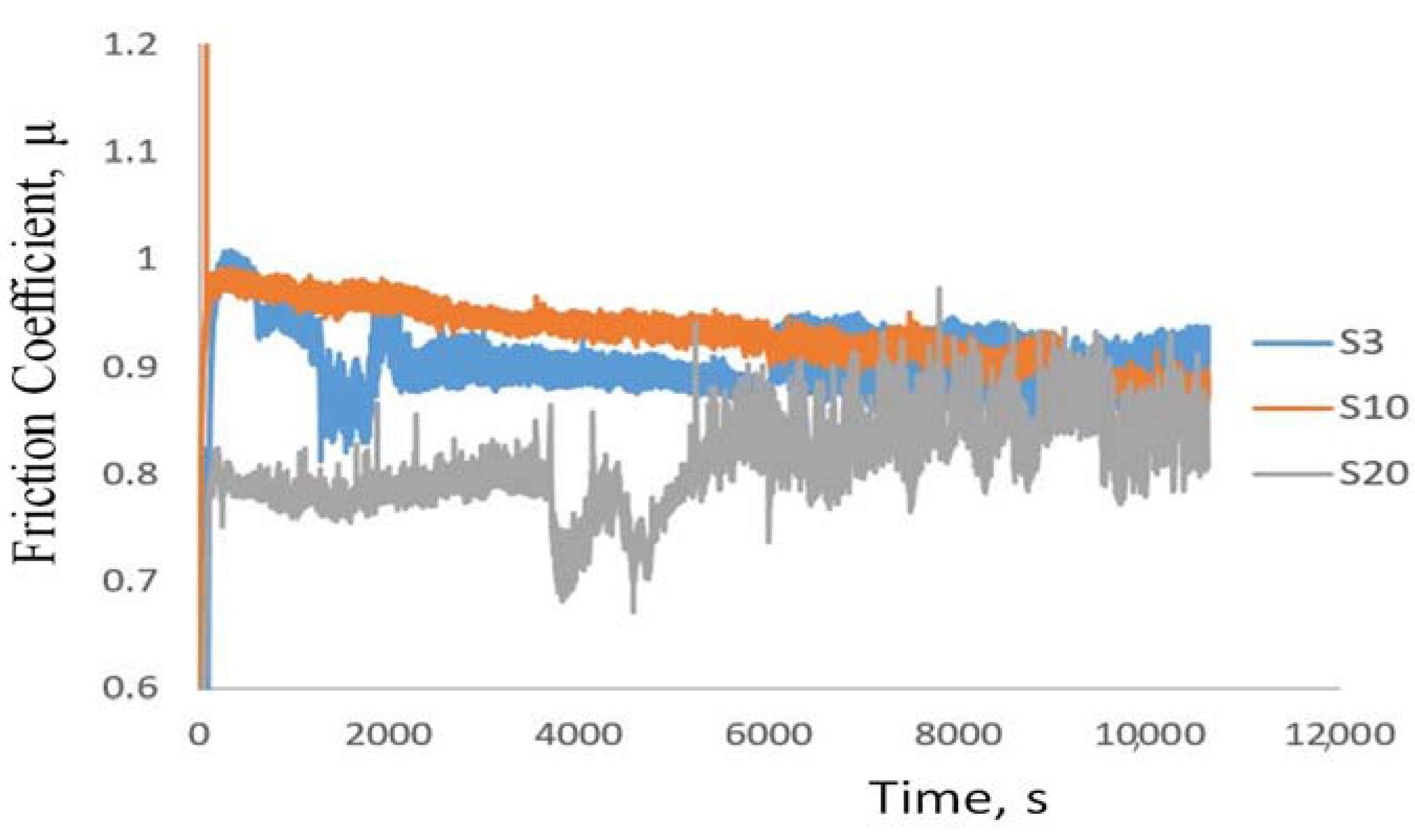
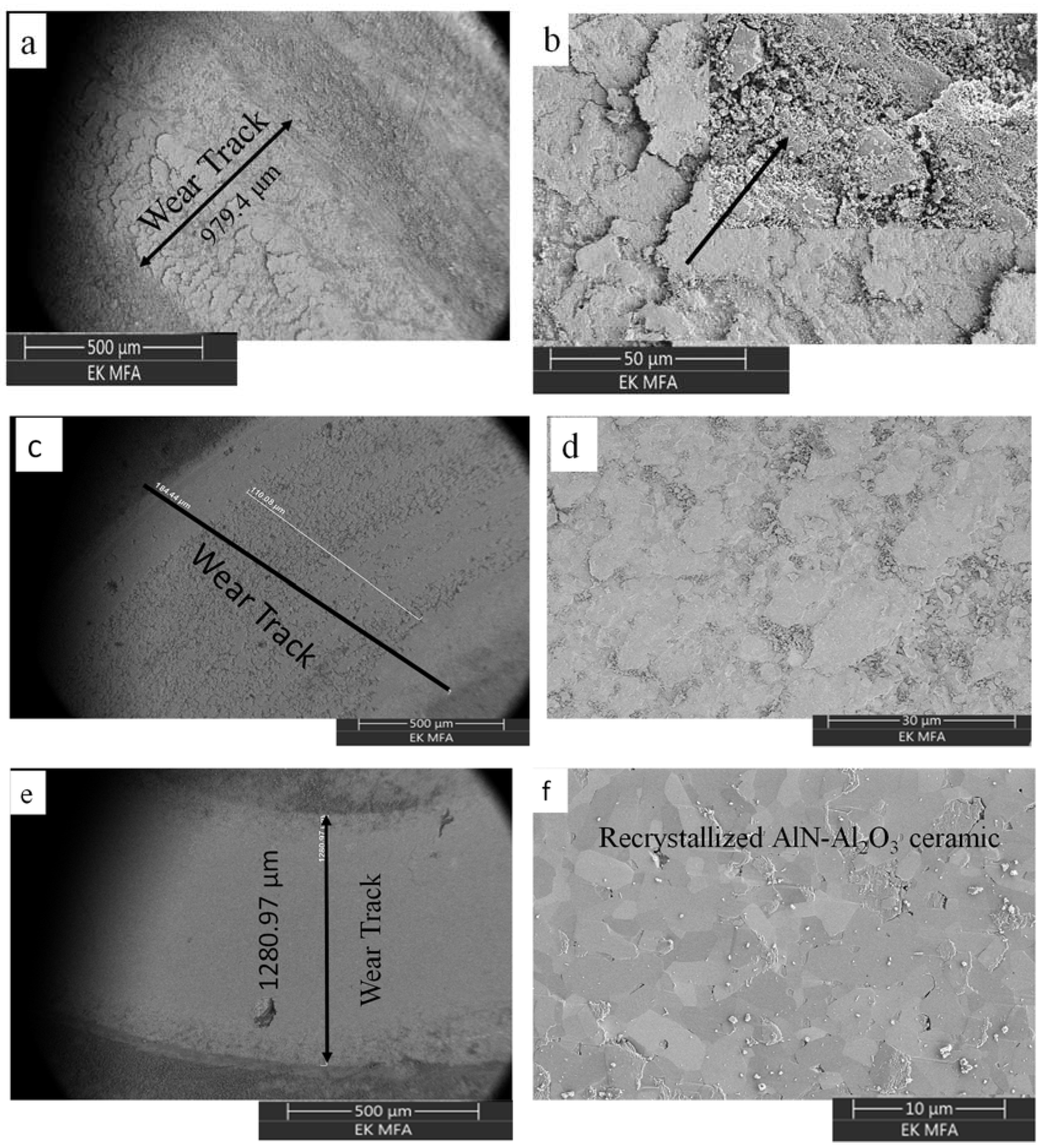
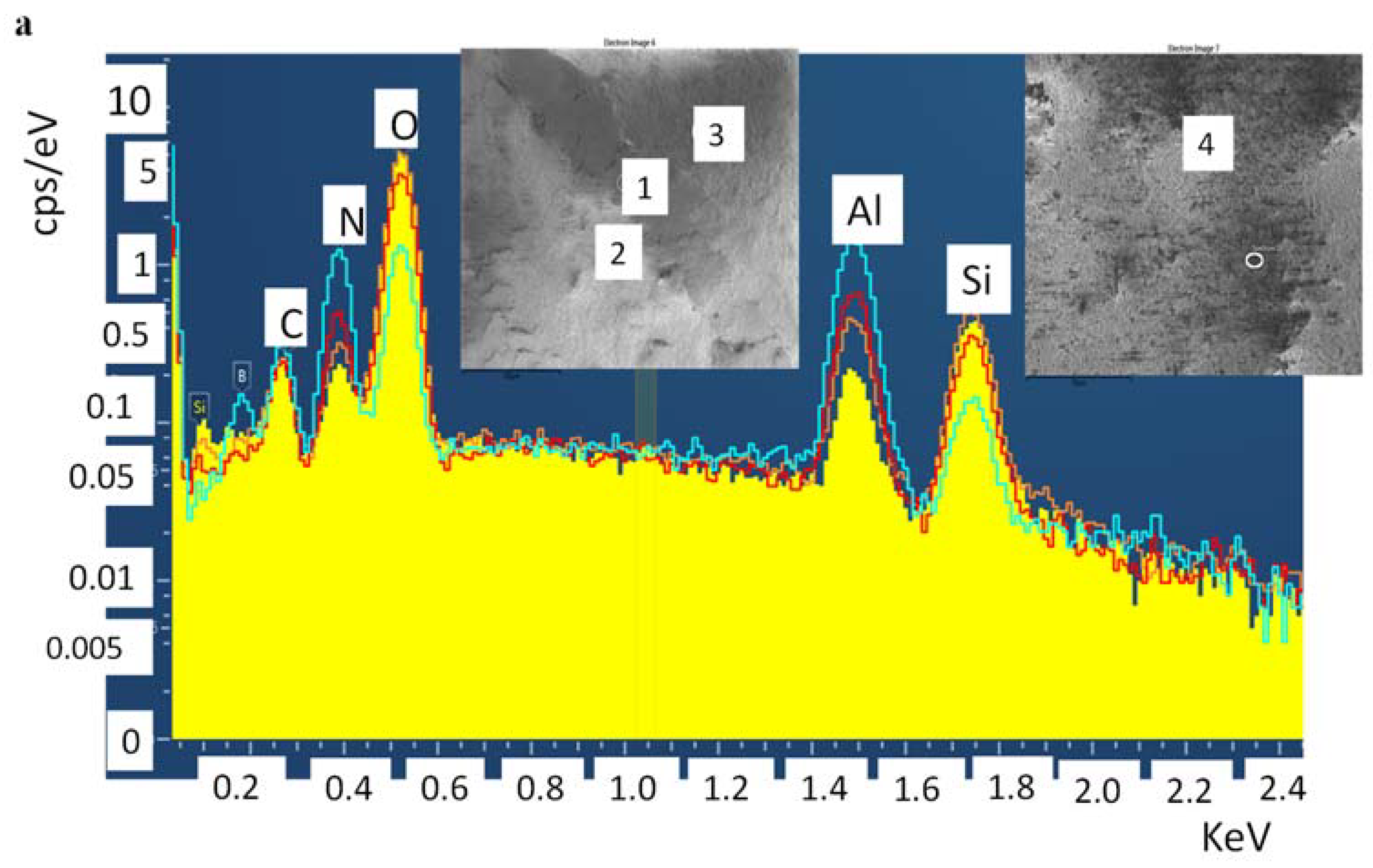

| Sample | Oxidation Time of Sample (h) | Apparent Density (g/cm3) |
|---|---|---|
| S0 | 0 | 2.57 |
| S3 | 3 | 2.87 |
| S10 | 10 | 3.37 |
| S20 | 20 | 3.10 |
| Sample | Wear Track Width, d (mm) | Volume Wear, V (mm3) | Wear Factor, K (mm2/N) |
|---|---|---|---|
| S3 | 1.434 | 2252.95 | 0.000225 |
| S10 | 1.575 | 2482.5 | 0.000248 |
| S20 | 0.954 | 1486.1 | 0.000149 |
Publisher’s Note: MDPI stays neutral with regard to jurisdictional claims in published maps and institutional affiliations. |
© 2021 by the authors. Licensee MDPI, Basel, Switzerland. This article is an open access article distributed under the terms and conditions of the Creative Commons Attribution (CC BY) license (https://creativecommons.org/licenses/by/4.0/).
Share and Cite
Varanasi, D.; Furkó, M.; Balázsi, K.; Balázsi, C. Processing of Al2O3-AlN Ceramics and Their Structural, Mechanical, and Tribological Characterization. Materials 2021, 14, 6055. https://doi.org/10.3390/ma14206055
Varanasi D, Furkó M, Balázsi K, Balázsi C. Processing of Al2O3-AlN Ceramics and Their Structural, Mechanical, and Tribological Characterization. Materials. 2021; 14(20):6055. https://doi.org/10.3390/ma14206055
Chicago/Turabian StyleVaranasi, Dheeraj, Monika Furkó, Katalin Balázsi, and Csaba Balázsi. 2021. "Processing of Al2O3-AlN Ceramics and Their Structural, Mechanical, and Tribological Characterization" Materials 14, no. 20: 6055. https://doi.org/10.3390/ma14206055
APA StyleVaranasi, D., Furkó, M., Balázsi, K., & Balázsi, C. (2021). Processing of Al2O3-AlN Ceramics and Their Structural, Mechanical, and Tribological Characterization. Materials, 14(20), 6055. https://doi.org/10.3390/ma14206055









